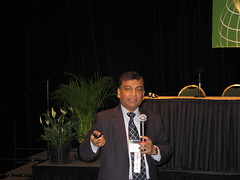
Sailendra Pattanayak, Senior Economist, Fiscal Affairs Department, the International Monetary Fund, discussed Treasury Single Accounts (TSA). He suggests that the TSA aids cash management and facilitates other functions in public financial management. He presented diagrams showing the typical payment system with many bank accounts and the use of a TSA.
Mr. Pattanayak pointed out the TSA handles payments from all spending units separately. Unlike the use multiple bank accounts, the cash balances roll up to a single account.
The TSA is not just a single bank account. It can be multiple accounts rolled up to a single accounts. Mr. Pattanayak pointed said that the TSA is a unified structure of government bank accounts that gives a consolidated view of government cash resources. It could be just one account or a set of linked accounts (main and subsidiary). He warned that as far as possible, all public entities should be consolidated to the TSA. The TSA should be legally recognized, institutionally robust and stable according to Mr. Pattanayak.
Mr. Pattanayak agreed with previous presentations on cash management in that cash controls should be de-linked from budget controls. He emphasized that the TSA can contain ledger sub-accounts for control and monitoring purposes, but these should not contain over-night balances. He said that options for accessing the TSA is mainly dependent upon institutional structures and payment settlement systems. The cash balance in the TSA is maintained at a level sufficient to meet daily operational requirements of the government according to Mr. Pattanayak.
The TSA is nothing new according to Mr. Pattanayak. He warned that revenue and expenditure transactions should be classified through a well-developed chart of accounts and not by maintaining distinctive bank accounts for them. He recommends that the TSA should be maintained in the national currency because budget execution is in the national currency.
The benefits of the TSA includes:
- Ensures complete, real-time information on government cash resources
- Helps preparation of accurate and reliable cash flow forecasts
- Optimizes the cost of government operations
- Facilitates efficient payment mechanisms
- Improves operational and appropriation control during budget execution
- Enhances efficiency and timeliness of bank reconciliation
- Facilitates timely and more complete accounting statements/reports
- Co-operation of the line ministries
- Development of an Interbank settlement/clearing system
- Real Time Gross Settlement System (RTGS) at the central bank for high value transactions
- Major commercial banks and treasury connected to the RTGS
- Development of a small payments clearing system
Mr. Pattanayak described the coverage of the TSA. The minimum is to manage the entire central government. Public corporations are generally not included in the TSA. He described the possible integration of social security and other trust funds.
Mr. Pattanayak described how the TSA could include both central and sub-national governments. He also described the integration of transaction processing with government accounting systems. He warned that centralized payment systems can lead to inefficiencies and high transaction costs without IFMIS automation and accounting controls.
Many donors are concerns about putting funds into the TSA:
These donor issues can be addressed by activities such as the separation of currency sub accounts according to Mr. Pattanayak
- Assurance for use of donor aid on specific projects (or non-diversion of funds)
- Some ring-fencing to avoid liquidity problems (and ensure timely payments during project execution)
- Minimize exposure to exchange related fluctuations/losses in the value of donor aid (when currency exchange rate regime is volatile)
- Reliability of controls (in managing donors’ funds) and information produced by the national PFM systems
Mr. Pattanayak described some of the issues that need to considered when designing a TSA. He described country-specific issues. He recommended that the design of the TSA should form part of the design of an Integrated Financial Management Information System (IFMIS). He described the preconditions for establishing the TSA including political support, regulatory requirements and the need for technological integration. He emphasized the need to formalize banking agreements. The Chart of Accounts may need to be extended to cover non bank expenditure transactions. He pointed out that moving to a TSA will require some capacity development among users.
Sailendra pattanayak ts apresentation es
View more presentations from icgfmconference.





No comments:
Post a Comment